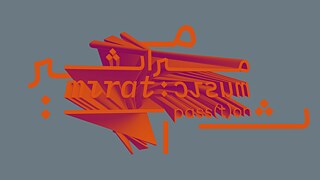Collective Track – A Musical Landscape
Having been separated physically by the pandemic, each musician took it upon themselves to share a concept or a sound that was close to their hearts, only to pass it on to the next musician so that they, in turn, respond to it musically. The artists worked with music as an intangible form of cultural heritage, prompting in the process questions about the meaning and use of “heritage” and highlighting the cultural diversity that each one of them was able to tap into and share with the others.
The piece starts with Ghassan Sahhab’s composition on the qānūn, which is based on the song “Ya Falastiniya” by the eminent Egyptian composer and singer Sheikh Imam. The Lebanese qānūn player, composer, academic and researcher chose to use “Ya Falastinya” for this composition while witnessing the latest uprising that took place in Occupied Palestine in May 2021, and the aggression on the Gaza Strip. This piece, therefore, is grounded in the musical history of Egypt and the Levant, using one of the principal instruments of the takht (the chamber group or ensemble in the modal/maqam tradition consisting of the ‘ud, qānūn, violin, nay and riqq).
The track progresses over synthesized contemporary sounds, accompanied by the dreamy bass guitar tunes of Jordanian multi-instrumentalist and composer Yacoub Abu Ghosh. Abu Ghosh picks up where Sahhab has left, with a particular maqam/mode called maqam sīkāh, which evokes in Abu Ghosh’s mind a traditional dabke dance tune from the Maan region. Yacoub uses the maqam’s rhythmic melody to complement Sahhab’s work, using electronic synth and percussion, in addition to bass guitar.
From the dabke rhythms of Maan, Amel Zen’s Algerian Amazigh influences carry the music into new regions and sounds. In a spontaneous take on the previous contributions, Amel Zen connects through a widely spread 6/8 rhythm from Algeria and the big Maghreb (Northwest Africa). Her music is inscribed into the composition as an urgent call to rehabilitate the history of North Africa and the identities of its peoples. The artist called her contribution “Tamazgha” (a toponym in Berber languages denoting the lands traditionally inhabited by Berbers), an endeavor to revive the thousand-year-old heritage of her Amazigh compatriots. Inhabiting a prominent and unique musical space, the artist’s composition serves as a living witness to her people’s cultural heritage.
Similarly taking the listener to another struggle for justice and independence is Zaid Hilal’s piece “Haddi Ya Bahar” (meaning “Calm down, sea”). The song belongs to the Palestinian folk repertoire, and was composed and sung by Abu Arab, a pioneering folk musician, often dubbed “the poet of the revolution”- in reference to the 1936 Arab Revolt. Directly influenced by the recent aggressions on Palestinians in Sheikh Jarrah in the spring/early summer of 2021, Zaid Hilal takes the “popular memory” of his surroundings and re-arranges Abu Arab’s masterpiece with electric and acoustic guitars, percussion, bass guitar and synths.
A split-second silence indicates a new beginning, then the track resumes with the local African rhythms of Sudan. The Darfur-based musician, singer and composer Mohamed Adam brings together three under-documented and under-represented musical styles from his local community to share the rich diversity of Sudanese rhythms.
Starting with the kewal or kewet, Mohamed introduces one of Darfur’s most widespread musical and dance rhythms, whose movements are inspired by camels. This style is prevalent among the Beja tribes, who live on the coast of the Red Sea in the East of Sudan. The kewal dance is often a display of masculine power, as men brandish their swords, dressed in the jalabiya (a loose-fitting, traditional Egyptian garment), long sirwal (a form of baggy trousers) and sideiri (a sleeveless jacket resembling a waistcoat). Instrumentally, the music uses the masinko (a form of bowl lyre), and depends heavily on clapping to maintain rhythmic harmony.
Embedded within Mohamed’s track is another musical style called franqabiya الفرانقابية -meaning “the gazelle’s body”- in an allusion to the origins of the dance moves. This music and dance style belongs to the For tribes of West Sudan, who perform it on religious and social occasions, bringing together men, women and children through the love of dance and movement. The dance also provides a space for the exchange of gender roles, as women dress in men’s attire and vice versa, with heavy accessories which rustle and jingle in line with the music.
The third style incorporated within Mohamed Adam’s piece is that of the mardoum, a rhythm associated with the Baggara tribes found in the west and south of Kordofan in Sudan. Similar to the previous styles from Sudan, the mardoum is linked to the eponymous dance, in which men line up opposite women and start stumping their feet and jumping in a manner inspired by the movement of fast trotting cattle. Women are often organized into singing groups, with each taking part in the singing. The hakkamat حكامات (wise ones or main singers) and the shayyalat شيالات (chorus) take turns in singing the lyrics of the songs, which often concern chivalry, generosity, praise and love. Each group repeats their part alternatively, while men whistle and respond with powerful tones.
The African rhythms of Sudan then transition into mighty, energetic and repetitive Kurdish rhythms on the daf and other percussive instruments, led by esteemed Kurdish percussionist Hajar Zahawy. Here, the artist selects rhythmic patterns present in the compositions of his fellow musicians, and builds his section on the commonality of these fast 6-beat patterns which are present across the musical knowledge of West Asia and North Africa.
The music then alters into evocative and ambient electronica by Tunisian electronic sound producer Rehab Hazgui. The artist adds an imaginative landscape which translates the inner state of the musician, both a vast site of projects and deeply layered terrain of remains, memories and histories. Her sounds mark the resonances of fragmentation and isolation, and generate intriguing rhythms and distorted sceneries.
The last part of the track closes the instrumental and compositional circle as the traditional qānūn returns in the midst of distant and dreamy synthesized and ambient electronica, thereby altering the mood into a contemplative and dark space of searching inwards and within. This commanding act of interweaving subtle electronica with the qanun, which approaches the listener from a distance, evokes a futuristic air of presence and absence, before fading away, indicating an end and a farewell.
The collective track was realized through a collaboration spread over two cycles. In the first cycle each artist responds creatively to the other, by musically picking up the composition where the previous artist has left it, and then passing it on to the next one. In the second cycle, artists were asked to enhance the sounds of their colleagues by adding their own musical touches. Hence, Yacoub Abu Ghosh’s musical concepts are heard in the words of Ghassan Sahhab and Hajar Zahaway; Ghassan Sahhab’s philosophy and music is applied to Yacoub Abu Ghosh and Zaid Hilal’s; while Rehab Hazgui utilizes the works of Ghassan and Yacoub as the basis for her own composition. This process cemented a lasting musical synergy of varying concepts and experiences.
While the physical distance between the artists is audible in their creations, the enormous energy they channeled into meeting musically on one track can be felt heartily in this 15-minute intersection of geographies, instruments, language, musical knowledge and histories.

